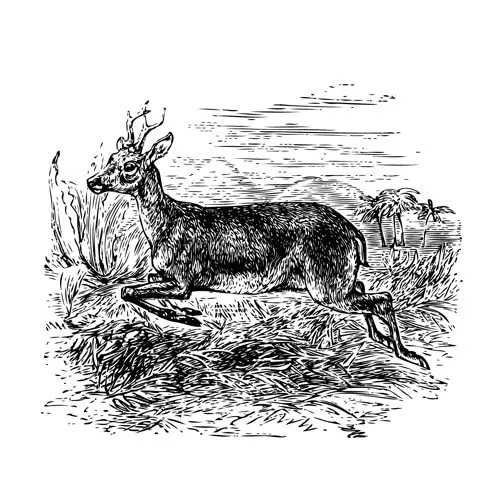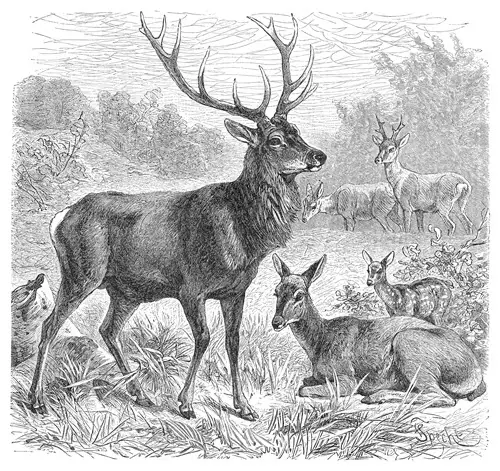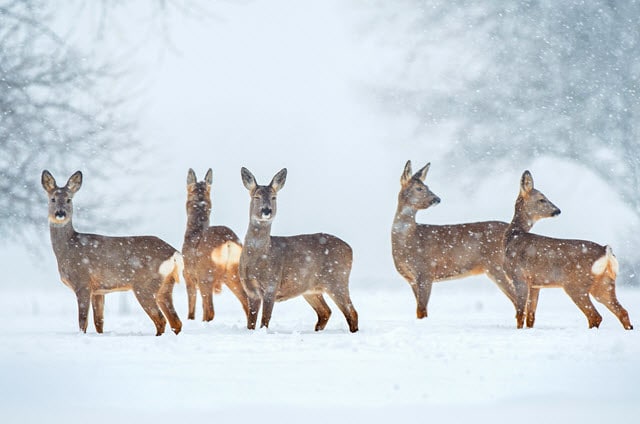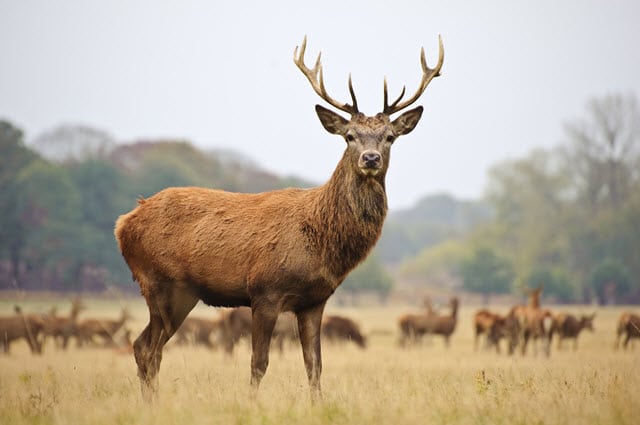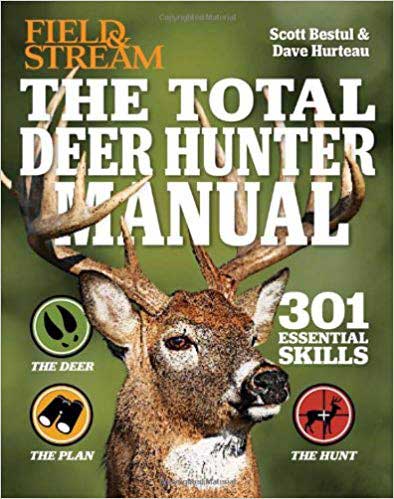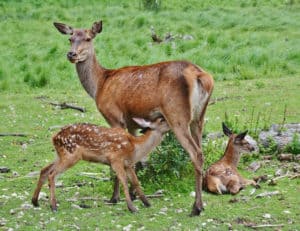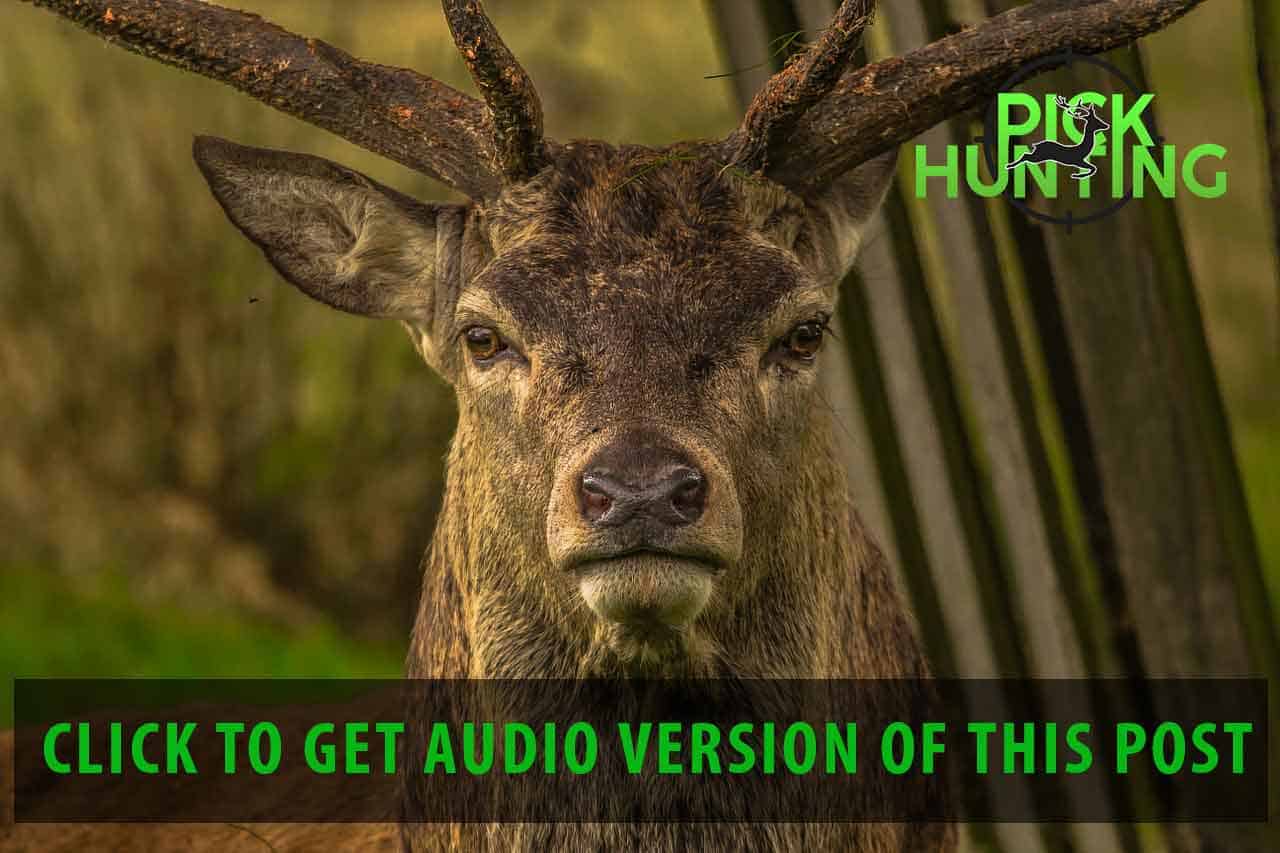How do you describe more than one deer, from a perspective of spelling and grammar? It can be a common question among our dear readers, so we’ll address it in today’s discussion.
Let’s arrive at the proper plural of deer, as well as how to make sense of similar questions.
What Is the Word for the Plural of Deer?
Simply put, the plural of deer is deer. So, any of the following sentences would be correct:
I saw a single deer peering out at me from the forest.
While biking across a mountain trail, I came upon a group of deer drinking from a stream.
Several deer were sprinting gracefully through the clearing in the distance.
Why Is the Plural of Deer and Not Deers?
If you came to this article because you were wondering about the plural of deer, the answer might seem confusing at first. After all, similar words are made plural by adding an “-s” to the end. For instance, the plural of beer is beers. So why does the singular deer not become the plural deers?
There are a few reasons for occasionally inconsistent pluralization in English. Our language has drawn many of its words from other languages such as Greek, Latin, and Arabic and inherited nonstandard pluralization as a result. In those cases where we have borrowed and adapted foreign words, the correct plural versions might seem unusual because of their origin with another system of spelling and grammar.
Such words can often be pluralized differently because adding an “-s” would make them difficult to spell or say out loud. For example, the singular knife becomes the plural knives because the incorrect knifes could be more difficult for people to say and hear. This explains why we have plural words such as geese instead of gooses as well.
Some words also are changed by simple convention. American English is a living language that has continued evolving from its British roots during the last several centuries. Words that may have once been spelled or spoken one way have become something different in our modern American society.
The best way to master nonstandard pluralization is to simply become familiar with the variations by reading and writing them with a focus on their correct usage. You can also continue your study of irregular plurals with posts such as Irregular Plurals and Irregular Plural Nouns.
Want More Help With Your Grammar?
Learning grammar can be fun and interesting if you have a desire to develop your precision and eloquence in communicating with others. If you want to enhance your abilities as a communicator, review some of our recent posts with insight and guidelines for other common items of grammar and spelling. You can also ask a question about this post or suggest a future topic in the comments below!
Advertisement
If the article or the existing discussions do not address a thought or question you have on the subject, please use the «Comment» box at the bottom of this page.
Whether you’re learning to speak English or are a native speaker, the word “deer” can be confusing. What’s the plural of deer? Well, the answer is really quite simple. The plural of the word deer is “deer”. The same form of the word is used for both singular and plural references to this animal. For example, you can talk about a single deer or several deer.
Is Deers a Word?
While “deers” is considered an accepted plural according to Grammarist and other websites, it is rarely used and may be considered incorrect. “Deer” is the preferred plural form of the word deer.
How Deer is Used in a Sentence
An example of using the singular form of deer would be: “Did you see the deer in the backyard this morning? It was beautiful.”
An example of using the plural of deer would be: “Look at the deer! There must be 20 of them in that field.”
Now let’s take a closer look at the word “deer” and its evolution and uses today.
The Etymology of the Word Deer
Like many other English words, the word deer and its usage depends on its history. Put simply, the singular and plural forms of deer have always been the same.
The history of the word deer stretches back several centuries. We find the beginnings of its usage in Old English. This version of English spanned from around 400 AD to 1066 AD in England.
It was in Old English that it was decided that deer should have the same form in both singular and plural uses.
This is because of the characteristics of Old English, which used a case system. Modern English no longer uses a case system. We are able to achieve the same objectives through word order.
With the structure of Old English, speakers were able to use the same forms for the singular and plural versions of words.
We see remnants of this in how we use the same form of the word deer for both the singular and plural forms.
Why Singular and Plural are the Same
As we talked about earlier, some English words have the same form for both singular and plural uses. The reason for this is simple: it’s a result of the words’ etymologies (history and development).
There are other English words that have the same form for the singular and plural versions. Notably, many of them refer to animals, specifically wild animals that are sometimes hunted or live on farms.
Let’s take a look at some of them below:
- Antelope
- Buffalo
- Moose
- Sheep
- Fish
- Elk
- Moose
There is some variability in usage when it comes to these words, however. For example, you may hear some people refer to plural fish as “fishes.”
However, with some of these animal names, it’s extremely unusual and sounds dramatically incorrect to create a different plural form.
An example would be moose. Wouldn’t it sound strange to hear someone say “mooses”? What about “buffalos”? These are obviously incorrect.
Of course, there are plenty of animals that have names with different singular and plural names. An example is the cow. One cow is a cow, while the plural of cow is cows.
How to Find out if Deer is Singular or Plural
This is one of the trickiest elements of learning English. Sometimes, there isn’t a definite reason for a usage convention.
This certainly applies to somewords that have the same singular and plural forms.
In many cases, we need to get to know and even memorize, through practice, the different words that have the same singular and plural forms.
You can always be sure that deer has the same form when both singular and plural. There is no context where saying “deers” would be correct when referencing a group of deer, though people may understand what you are saying.
But if you’re looking at a sentence and see the word “deer,” how do you know whether the writer was talking about one deer or more than one?
You can tell from the context and other things said in the sentence. For example, if it says “I saw several deer in the field,” it is clearly plural.
What are Collective Nouns?
While deer is a noun and the singular and plural forms are exactly the same, it’s not a collective noun. A collective noun is a noun that refers to a multitude of things.
For example, the collective noun for a group of geese would be a “gaggle.” We talk about “gaggles of geese,” meaning groups of geese.
When it comes to deer, we talk about a “herd” or sometimes a “group” However, these collective nouns are also used for other animals. When it comes to the word “group,” this is also used for humans.
Final Thoughts: Deer or Deers?
As we’ve seen here, the plural of deer is the same as the singular form, which is “deer.” The word “deers” is an accepted plural form of the word, but it is almost never used and is considered less correct.
While many other animal names have different singular and plural forms, deer does not.
English is quite an idiosyncratic language, and there aren’t uniform rules that apply to every word.
You will learn which words have different plural forms and which don’t through practice and getting better acquainted with the language.
You May Also Enjoy:
Some of us if not many have used the word “deers” for addressing a group of deer. When we see several individual deer walking in a group we tend to call it a herd of deer. A group of deer can be also referred to as a bunch of deer or a mob of deer. In the English language, there are certain grammatical rules that are to be followed in order to express the plural form of it. Keep rolling and learn interesting facts about the plural of deer!
What is the plural of deer? Grammatically, the exact plural of deer is “deer” not “deers” as it comes from irregular plural nouns. However certain extension words like “mob of deer”, a “bunch of deer” and sometimes a” herd of deer” can also be used to get plural like impact on the word “deer”.
Deer can be used as both singular and plural according to context. For example, “two deer”, “three deer” cannot be written as “two deers” or “three deers”.Like fish and sheep, the plural forms of certain nouns are the same as the singular. Such nouns are knowns as irregular plural nouns in the English language. To make them plural, we need the support of collective nouns
Names of Animals with no plural at all
Certain animals have no plural form just like deer. These are also known as zero plurals:
| Singular | Plural |
| Sheep | Sheep |
| Moose | Moose |
| Elk | Elk |
| Fish | Fish |
| buffalo | buffalo |
| antelope | antelope |
Here is a list of more irregular plural nouns that may also help you to know more about plural forms of common nouns.
Collective nouns of different irregular plurals
Generally, the animals that don’t have a plural form are explained by some unique collective noun. There are also collective nouns for animals having plural forms. For better understanding, a list of collective nouns is given below.
Shark: a shiver
Skunk: a stench
Jellyfish: a smack
Buffalo: a gang or obstinacy
Elk: a gang or a herd
Fish: a school
Fox: a charm
Geese: a gaggle
Jellyfish: a smack
Shark: a shiver
Skunk: a stench
Snakes: a nest
Squirrels: a dray or a scurry
Stingrays: a fever
Swans: a bevy or a game (if in flight: a wedge)
Tigers: an ambush or a streak
Toads: a knot
Turkeys: a gang or a rafter
Turtles: a bale or a nest
Weasels: a colony, a gang or a pack
Whales: a pod, a school, or a gam
Wolves: a pack
Zebras: a zeal
Mules: a pack
Otters: a family
Oxen: a team or a yoke
Owls: a parliament
Parrots: a pandemonium
Pigs: a drift or drove (younger pigs) or a sounder or a team (older pigs)
Porcupines: a prickle
Rabbits: a herd
Rats: a colony
Camels: a caravan
Cats: a clowder or a glaring, Kittens: a litter or a kindle, Wild cats: a destruction
Cobras: a quiver
Crocodiles: a bask
Crows: a murder
Dogs: a pack, Puppies: a litter
Donkeys: a drove
Eagles: a convocation
Elephants: a parade
Falcons: a cast
Ferrets: a business
Flamingos: a stand
Rhinoceroses: a crash
Frogs: an army
Giraffes: a tower
Gorillas: a band
Hippopotami: a bloat
Hyenas: a cackle
Jaguars: a shadow
Kangaroos: a troop or a mob
Lemurs: a conspiracy
Leopards: a leap
Lions: a pride
Moles: a labor
Monkeys: a barrel or a troop
Apes: a shrewdness
Badgers: a cete
Bats: a colony or a camp
Bears: a sloth or a sleuth
Bees: a swarm
Word deer originated from Old English word deor, a German word, tier and Dutch word, dier Once deor meaning was a four-legged animal. Only historic Linguists can tell us the exact reason why certain words like deer may not have plural forms.
In the oldest recorded English, deer came from neuter declension with no particular plural endings in both nominative and accusative cases. With time a large number of neuter nouns acquired ending like -s,-es but fewer like deer did not. For this reason, plural forms of certain words in English are the same as the singular.
Are deers correct when referring to different species?
“Deers” is not widely used term for the plural or even referring to other species of deer like reindeer, elk, red deer, etc. However, fishes can be used in a context when referring to different species. Deer is more like sheep in this case. Both can never be used to refer species as “species of deers” or “species of sheeps”.
Deer or Deers?
In English, to make a noun plural, you just have to add a /s/ to the end, some of the time. Other times you need to add /iz/ or /z/, or change the vowel, or change -up to -a, or -us to -i, or change absolutely nothing at all. Why is this? The normal -s suffix comes from Old English -as, which comes from Proto-Germanic *-ōs and dates back to Proto-Indo-European *-es /iz/ is used as a suffix in words ending in sibilant sounds, /s/, /z/, /ʃ/, /ʒ/, /tʃ/ and /dʒ/ Like fences, or hedges Why? Well, try pronouncing a -s or -z after one of these sounds with no vowel in between Words ending in -ex end in -ices when made a plural, like vertices or appendices.
Because Latin words ending in -is end in -es when made plural, like axes Because Latin Some words ending in -a end in -ae when made plural, like formulae Because Latin Some words ending in -us end in -I when made plural, like fungi Because Latin Some words ending in -um end in -a when made plural, like millennia.
Why does Latin have so many different plural endings?
Because in Latin, there are three genders, and six cases, many of which have different plural endings from each other. Why is the plural of child children? Well, Old English had other plural suffixes, -en and -an During the middle English period, people changed some plurals to use the -en suffix, such as changing englas, angels, to englen The -en suffix was also added to some plurals, such as childer, plural of child, forming children Why is the plural of goose geese, but the plural of mongoose isn’t mongeese, and the plural of moose isn’t meese? In Old English, another way that plurals were formed was by changing the vowel sound of the singular.
The reason the plural of mongoose isn’t mongeese is that mongoose is a loanword from the Marathi mungus. The reason the plural of moose isn’t meese is that it’s also a loanword, from an Eastern Algonquian language. Why do words that end in f in singular form end in v in plural form, like leaves? In Old and Middle English, /f/ and /th/ sounds became /v/ and /th/ sounds when in between vowels. And in Old and Middle English, the plural suffixes -as and -en started with vowels. Why is the plural of person people?
The person comes from the Latin persona, originally meaning character in a play, but then changing to mean an individual human being People comes from a different Latin word, populum, meaning people more in the sense of population Why is the plural of sheep still sheep and deer still deer? In Old English, neuter nouns had no plural ending in the nominative and accusative cases.
What is The Plural of Male Deer
The male deer is called a buck. Although the word deer doesn’t use/s/ or /-es/ in the plural form, several male deer can be called bucks. The male deer is called a buck after 1 year of its birth. The bucks are usually not seen in a group or herd.
What is The Plural of Female Deer
The female deer is called a doe. The plural form of a doe does. The female deer are often seen is a bunch. The male fawns leave there mother after they are matured whereas the female fawn can either choose to stay with her mother in a group or choose some other group to blend with.
Frequently Asked Questions
What do you call more than one deer?
Simply more than one deer is called two deer, three deer, four deer and so on. We cannot say “two deers” or “three deers”
What is the plural of a female deer?
“Doe” is the word we use for female deer. To make it plural just add _s as “does”
What does plural form mean?
Plural form means “more than one of a particular noun or pronoun. It shows the actual number of nouns and pronouns
What is the plural of an ox?
The plural form of “Ox” is “Oxen” not “Oxes.”This is because certain words with_en endings have a German origin. This word Oxen may be derived from German sources in Old English.
What is the plural of reindeer?
Like deer, the plural of reindeer is also reindeer. However, certain dictionaries may also support” reindeers”
Why Deer has no plural?
Word “deer” originated from Old English word deor, a German word, tier and Dutch word, dier. With time majority of nouns acquired plural forms with-s or -es addition. Only a few like deer are still without plurals. This is all because of the etymology of the English language and deer word itself.
What is the number of deer?
Deer is one of the most adaptive densely populated mammals all over the world. It is not easy to count the exact number of deer across the globe. However, in the US only more than 30 million deer are living today.
What is the meaning of deer and dear?
Both deer and dear have the same pronunciation as homophones yet totally different in meaning. Deer is a “four-legged animal” while “dear” is used to address a person who is loved and it is also used to show surprise feeling as interjections.
Now, if you want to download the pdf version of this post then let’s download by clicking the image below:
Final Verdict
Knowing, what is the plural of deer? is helpful not only for hunters but also for students and researchers of wildlife. In this way, they can use the right word for the right thing.
As you already know that the plural form of deer is deer. Using the plural form of deer as ‘deers’ is grammatically incorrect. If you will, you can use collective nouns to express a large number of deer grazing around an open field.
If you are interested to know more about deer behavior, read this book and be a successful hunter!
You can read some of our related guides like male deer, female deer, what sound does a deer make, how long are deer pregnant, what should be used to screw on broadheads, etc.
Now, if you want to listen to the audio version of this post then let’s listen:
Deer is the preferred plural form of deer, a hoofed mammal. Deer are ruminants. In most types of deer, only the males produce antlers. Deer antlers are shed annually. Some species of deer are white-tailed deer, red deer, caribou, moose, fallow deer, mule deer, roe deer and elk.
Deers is an accepted plural, but it is rarely used.
The word deer comes from the Old English word, deor, which means four-legged animal, beast. Also the Dutch word, dier and the German word, tier.
Deer is one of a set of words with irregular plural forms, such as sheep and fish.
Examples
Officials recently said Michigan’s 2014 deer hunting harvest was down about 15 percent from 2013, due in part to severe winter weather in recent years. (The Detroit News)
The company sells breeding stock, while trying to improve offspring to produce male deer, known as bucks, with the big antlers and other characteristics often favored by hunters and game farms. (The Journal Times)
“The number of deer harvested hit a low in the early 1970s at below 100,000 statewide,” Creagh said. (The Daily Journal)
“People assume deer will learn to look both ways, and the dumb ones will be selected out of the population,” said Sandra Jacobson, a wildlife biologist with the U.S. Forest Service’s Pacific Southwest Research Station in Davis, California. (Helena Independent Record)
According to the details submitted to the Ministry of Environment, Forest and Climate Change by Gujarat forest department, the floods claimed lives a whopping 1,670 blue bulls (nilgai), 80 spotted deers, around 10 black bucks and even wild boars that all form the prey base of Asiatic lions. (Daily News and Analysis India)
As a result, unexploded ordnance litters the 18sq km area, posing a threat to the deers, boar and foxes that roam its lands – as well as humans. (The Guardian)
Learning a new language can be an exciting and fruitful journey, but, at times, it can also be frustrating. Languages are constantly evolving with the people who speak it. This evolution introduces many exceptions that defy our expectations about how words should be formed. In the past, we’ve looked at quite a few of these plural exceptions including words such as chief and moose. The plural for deer is also one of these exceptions.
Deer is pluralized as ‘deer’ because of the word’s history. In old English, deer did not receive a plural ending. As English changed and developed, it retained this quirk throughout its development and remains the same to this day.
What is the plural for deer?
As mentioned above, the standard plural for the word deer is ‘deer’ and it doesn’t change. Much like many other similar words such as moose, elk, fish, sheep, etc.
This plural formation is actually fairly standardized among all members of the deer animal family. All these words remain the same between their singular and plural forms.
| Deer Family Animal | Plural |
|---|---|
| Deer | Deer |
| Moose | Moose |
| Elk | Elk |
| Reindeer | Reindeer |
| Caribou | Caribou |
All of these words use the same word for both their singular and plural forms. People like regularity and predictability in their language. This is why, as languages evolve over time, many irregularities are lost. This doesn’t mean that there will never be irregularities and exceptions to rules. These will always exist. Just like any other natural system. However, the trend is for similar words to share similar forms, so deer-like animals and other herding animals frequently don’t have a distinct plural form. If you’re interested in learning more, you can check out my article on the word ‘moose’ here, where I explore the interesting history of the word’s journey into English.
The reason why is rooted deep in the history of English. Way back to the period of English history known as ‘old English’. This was a period of English that lasted from roughly 400AD to 1066AD.
During this time, English had a very extensive case system which is now largely lost in modern English. A case system is a method of indicating the grammatical category of nouns. In modern English, this is achieved through strict word order. English is known as an SVO language. This means that subjects come first, verbs second, and objects last in simple sentences.
In some languages, such as French or German, nouns change based on their function in the sentence (whether they are subjects, objects, or serving some other function.) Believe it or not, this actually happens in English too. As mentioned above, English had a very robust case system during its earlier periods. While most of these case distinctions have been lost, some are still around to show us what this looks like. Consider the following sentences:
As you can see, pronouns have different forms when they are in the subject or object positions of a sentence. English pronouns are some of the only sets of words which completely transform based on grammatical category. Following is a chart showing these cases:
| Subject | Object |
|---|---|
| I | Me |
| He | Him |
| She | Her |
| They | Them |
| We | Us |
These are what we are left with after over a thousand years of English history, but back in the old English period, we had three full case systems for our nouns. If you are familiar with any other European languages, you most frequently hear these systems referred to as genders. Old English had three genders masculine, feminine, and neuter.
At this time, the word ‘deer’ was ‘dēor‘ and it was part of the neuter case system. Let’s take a look at the various forms of ‘deer’ at that time:
| Case | Singular | Plural |
|---|---|---|
| Subject | dēor | dēor |
| Object | dēor | dēor |
| Possessive | dēores | dēora |
| Indirect-Object | dēore | dēorum |
Did you notice anything about the way ‘dēor‘ transformed? That’s right! The form is exactly the same in both the singular and plural. This was true about all neuter words in old English. The singular and plural forms were the same. As old English developed into middle English and eventually modern English, these types of neuter words generally adopted the regular English plural (adding -s to the end of the word). This is actually true of ‘deer’ too.
Above is a chart showing the prevalence of the ‘deers’ form in English literature from 1800 to 2019. As you can see, earlier in English’s history. People tended to write ‘deers’ much more often than they do now. If we had data from even earlier time, we would see an even higher usage.
So why did ‘deer’ lose its -s?
It’s hard to tell for certain, but some theories suggest it happened due to analogy with other similar animal words. As we already saw above, other animals of the deer family do not receive an -s in the plural. This is the same for many other words for animals in English.
- Fish
- Sheep
- Swine
- Cattle
- Zebra (both ‘zebra’ and ‘zebras’ are acceptable in the plural)
We can analyze this phenomenon as being due to the “mass nature” of these types of herd (and schooling) animals. A big group of fish, cattle, swine, and deer look like a single entity, so speakers of English viewed these animals as such and regularized their plurals as being identical to the singular.
Something else you might not know.
There’s even some extra interesting information about the word ‘deer’ that you may not know.
Back in the period of old English, ‘dēor‘ was the word that the Anglo-Saxons used for any animal. It wasn’t a word specifically for deer. This usage for ‘dēor‘ to mean any animal was replaced by our current word ‘animal’ during the middle English period (1066AD to ~1400AD).
This kind of change in meaning is known as lexical narrowing. It’s a process where a word’s meaning goes from having a general meaning, to having a more specified one. The opposite of lexical narrowing is lexical broadening.
Ultimately, the word ‘animal’ comes from Latin. It is derived from the Latin word anima, which means ‘soul’ or ‘spirit’.
Conclusion
As we’ve seen, ‘deer’ has had a very long and interesting history in the English language. It went from being a general word used to refer to any animal and is now used as a word for a specific animal. Throughout that journey, the word changed and evolved along with English. Originally, it adopted a standard plural -s form, but as time went on it regularized with other English animal words to share the same form in the singular and plural. Just as it had back in the old English period.
Did you know that English is full of interesting stories like this? This article is a part of my series on the Hidden History of English. If you enjoyed this article, you can check out more from this series here.


